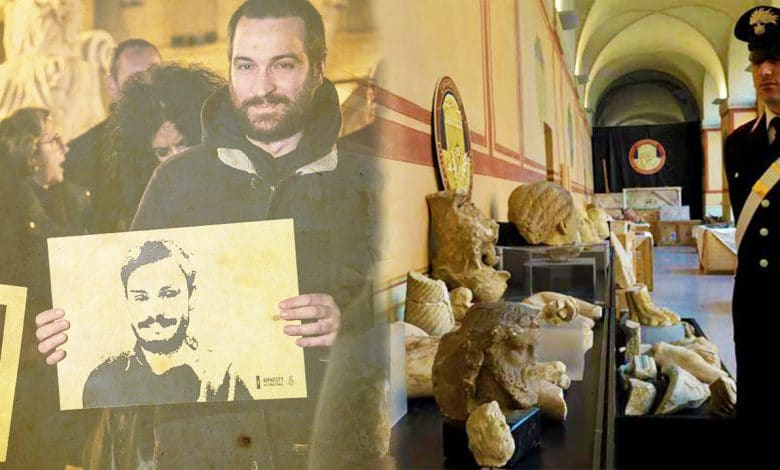
Can the “Grand Antiquities Case” Save Regeni’s Killers?
The legal proceedings known in the Egyptian media as the ‘Grand Antiquities Case’ has been circulated in the media since May 2018, following the seizure of a diplomatic container in the Italian port of Salerno, coming from the Egyptian port of Alexandria, containing more than 21 thousand different artifacts.
The involvement of an Italian diplomat alongside Egyptians in this case has been proven, as the Cairo Criminal Court last February gave heavy sentences to the Egyptian convicts in presence and to the Italian diplomat in absentia. After 10 months of this first-degree ruling, the Egyptian authorities started to demand the extradition of the Italian diplomat, which pushed some observers to link the timing of Cairo’s demand to hand over the ex-diplomat to Rome’s demand to extradite the murderers of the Italian researcher Giulio Regeni.
The question now is: Will the “Grand Antiquities Case” save Regeni’s killers from appearing before Italian courts?!
First: The ‘Grand Antiquities Case’
On May 22, 2018, Italian newspapers and TV channels announced that the Customs Authority of the Port of Salerno seized a diplomatic container coming from the port of Alexandria, Egypt. It was later found out that the diplomatic container contained 22 parcels, numbered from 1 to 22; but the parcels containing artifacts were registered in the name of an Italian called Massimiliano Sponville, who used to work at the Italian embassy in Cairo, went directly to Italian authorities after the case was revealed, and proved that he had nothing to do with these parcels.
The parcels contained 21,855 pieces of various antiquities, including 21,660 coins, 195 small artifacts, in addition to 151 small-sized ushabtis, 11 pottery vessels, 5 mummy masks, a wooden coffin, two small wooden boats, 2 canopy heads, and 3 colored ceramic tiles dating back to the Islamic era. Immediately, officials of the Egyptian Ministry of Antiquities announced that these pieces were not from the missing pieces of the Ministry of Antiquities’ warehouses or museums, but rather resulted from stealth digging and illegal excavations.
Then a specialized Egyptian committee was formed in coordination with the Italian side, where necessary measures were taken to recover these pieces and return them to Egypt again. In the fastest process of returning antiquities smuggled abroad, Egyptian artifacts were returned from Italy, accompanied by Dr. Mostafa Waziri, Secretary General of the Supreme Council of Antiquities.
Investigations that the parcels were sent from Egypt to a person called Ladislav Otakar Skakal, a former honorary consul of Italy in Egypt, not Massimiliano, that shipped those parcels in his name, so the prosecution ordered seizure of Sakkal. Investigations that lasted for a long time found out that there is a mafia for smuggling antiquities from Egypt, in which the former Italian honorary consul, the well-known Egyptian actor Boutros Raouf Boutros Ghali, brother of former Finance Minister Youssef Boutros Ghali, and Medhat Michel Gerges, owner of a public services company, and others were involved.
Raouf Boutros Ghali was arrested, but the Cairo Criminal Court released him on bail of EGP 50,000. At the same time, the Public Prosecutor ordered speedy arrest and bringing of Ladislav Otakar Skakal and including his name on the Interpol Red Notice list as well as domestic watch lists, and referral of other convicts to the criminal trial.
The prosecution also ordered search of the home of Raouf Boutros Ghali, two apartments in Cairo belonging to the Italian consul, and the home of Medhat Michel Gerges, owner of an Egyptian shipping company. The prosecution also ordered seizure of their money and properties and disclosing their bank accounts. More artifacts were found in the homes of defendants, and it was also uncovered that the former Italian consul had rented a safe at a famous private bank in Egypt, where Raouf Boutros-Ghali had the right to handle it. Investigations proved that there were financial transactions between the Italian consul and Raouf Boutros Ghali worth hundreds of thousands of foreign currencies in different periods of time.
After the prosecution completed investigations, the case was referred to the Cairo Criminal Court, which gave the convicts imprisonment sentences and obligated them to pay large sums of money according to the charges against them. The former Italian consul, as well as other defendants, were sentenced to 15 years in prison, and each was fined EGP 1 million.
However, the ruling was appealed; and the Court of Cassation, very quickly and unprecedentedly, decided on November 14, 2020, that is, only 9 months after the first-instance ruling, to set December 17, 2020 for the first hearings of the appeal submitted by Raouf Boutros-Ghali for participation in smuggling antiquities to Italy. The court also set December 24, 2020, to hear the first session of the other appeal submitted by Boutros Raouf Boutros Ghali against the first-instance ruling issued against him for committing crimes of concealing artifacts inside his home.
At the time of writing this report, the ruling of the Court of Cassation had not been announced despite passage of the scheduled session for the first appeal. However, rumors are circulated that the court accepted the appeal and canceled the first-degree ruling that had been issued against Raouf Boutros Ghali and others.
In fact, such ruling, in case of having actually been issued, is not surprising, given the fact that the case is politicized from the very beginning, and it was also expected that the convicts would be acquitted or at least given mitigated sentences, especially since the appeal session was set within only 9 months only, which had never happened before, as setting an appeal session at the Court of Cassation takes at least three years. Also, the Antiquities Protection Law leaves the door wide open for acquittal of convicts in such cases, as it will be explained hereunder.
Second: Antiquities Law and the “Grand Antiquities Case”
Observers of cases of smuggling Egyptian antiquities, strongly believe that the convicts involved in the “Grand Antiquities Case” and even in any similar cases will inevitably be acquitted. In fact, the Antiquities Protection Law No. 117 of 1983 is full of loopholes that allow such smugglers to escape punishment. Despite the successive amendments to the law, it still contains many loopholes. For example, although Article 41 of Law No. 91 of 2018 that raised the fine and the imprisonment period against anyone who smuggles antiquities outside Egypt, the legislator included a phrase in the article that would help the defendant to fully repudiate the charge, as Article 41 states that “Whoever smuggles an antiquity outside the republic of Egypt, together with his knowledge of such act: shall be punished by Intensive imprisonment and by a mulct not less than 1,000,000 (one million) Egyptian Pounds and not more than 10,000,000 (ten million) Egyptian Pounds. In this case the antiquity, object of the crime, shall be confiscated together with sets, instruments, machinery, and cars used in said crime for the benefit of the Council.“ Here, the phrase, “together with his knowledge of such act” allows the convict to completely disavow the charge and implicitly determines the acquittal of the convict during the first degree litigation.
As for Article (42) of the aforementioned law, which states: “Whoever steals an antiquity or part of an antiquity shall be punished with life imprisonment and a fine of not less than one million pounds and not more than five million pounds, whether the antiquity is registered within antiquities owned by the State, or intended for registration, or extracted from the Ministry’s archaeological excavations, or from the work of missions, bodies and universities authorized to excavate, with the intent of smuggling.” The last phrase “with the intent of smuggling” secures acquittal of the convict, as it is easy for any convict to prove that he did not intend to smuggle!
Indeed, Article (42 bis), which states: “Whoever hides an antiquity or part of such for the purpose of smuggling it shall be punished by intensive imprisonment for not less than 7 (seven) years and by a mulct not less than 1,000,000 (one million) Egyptian Pounds, and not more than 2,000,000 (two million) Egyptian Pounds. In all cases the antiquity, object of the crime, shall be confiscated together with sets, instruments, machinery, and cars used in said crime for the benefit of the Council.” How easy it is to get out of consequences of this article, especially since antiquities officials in Egypt immediately comment on such seizures with “not owned” by the Ministry of Antiquities and not registered in museums and archaeological sites, which gives a justification for the defendant’s defense to demand acquittal.
In fact, even the most recent amendments to the antiquities protection law in March 2020 added Article (42 bis 2), which states that: “Whoever attains, acquires, or sells an antiquity or part of such outside the Arab Republic of Egypt, unless he holds an official document proving its exit from Egypt in a legal manner, shall be punished by intensive imprisonment and by a mulct not less than 1,000,000 (one million) Egyptian Pounds, and not more than 10,000,000 (ten million) Egyptian Pounds. In all cases the antiquity, object of the crime, shall be confiscated together with sets, instruments, machinery, and cars used in said crime for the benefit of the Council.” I do not know what is meant by this suspicious article. How can an Egyptian attain or acquire or sell antiquities, while holding an official document proving that he legally transferred the antiquity out of Egypt?!
Third: Acquittal in similar cases
This part reveals some similar cases, which have ended up with acquittal of the convicts: In May of 2018, the Damietta Criminal Court, acquitted Ayman Al-Sayed in Case No. 14427 of 2016, where he had been accused of attempting to smuggle antiquities abroad through the Damietta port, although the convict was caught while trying to smuggle 5 Stone statues with ancient Egyptian inscriptions. In fact, there are almost countless similar cases, as seizure of persons attempting to smuggle antiquities abroad or have actually smuggled them, are published on a daily basis in Egyptian newspapers. However, there is a case very similar to the current “Grand Antiquities Case”, i.e. the case known as the “Germans case”.
What is the “Germans case”?
In 2013, samples of King Khufu’s cartouche (identifying inscription) were stolen from a small compartment above his burial chamber in the Giza’s Great Pyramid, by two German amateur archaeologists, and smuggled to Germany allegedly for study, according to a video clip they later released on YouTube. A German amateur archaeologist called Dominique Goerlitz together with a team including a German historian, Stefan Erdmann, and Jan Van Helsing stole small-sized samples of King Khufu’s cartouche and smuggled them to Germany for examination, where they later announced in a video clip on YouTube that they concluded that: Khufu did not build the Great Pyramid and that the ink used in the cartouche to record the details of the pyramid was not as old as the pyramid itself that was centuries older, concluding that the pyramid does not belong to Khufu and that its builders allegedly were the ancient Jews who lived in Egypt during the construction of the pyramid!!
In December 2013, Dr. Mohamed Abdel Maqsoud, head of the Egyptian Antiquities Sector at the time, said that the German government had not taken any legal procedures against the German researchers who stole samples from King Khufu’s cartouche although the Egyptian Ministry of Antiquities had addressed the Egyptian Ministry of Foreign Affairs and the Supreme Council of Antiquities had addressed the German Institute. The Egyptian Ministry of Antiquities also called on the German government to provide evidence that legal procedures had been taken against the German researchers. It also called upon UNESCO to intervene as the Great Pyramid is included in the organization’s World Heritage list.
In February 2014, the German ambassador to Egypt announced that the persons accused of stealing King Khufu’s cartouche had been transferred to the German Public Prosecution Office, which in turn seized the stolen items. In August 2014, the Egyptian Embassy in the German capital Berlin received the King Khufu cartouche’s stolen samples that had been smuggled by the two German researchers, where the Egyptian Ministry of Antiquities expressed appreciation for the German government for its sincere cooperation.
In November 2014, the Giza Criminal Court sentenced 9 defendants, including 3 Germans, to 5 years in prison, while the Egyptian defendants were dismissed from their jobs, and the court decided to refer Dr. Zahi Hawas to the Public Prosecution for his violation of the Antiquities Law, in the same case. In December 2014, the Giza Criminal Court deposited the reasons for its ruling to punish the convicts.
However, the defendants filed an appeal against the ruling before the Court of Cassation, and in December of 2015, the court decided to accept their appeal. In 2017, the court acquitted the defendants. However, the administrative prosecution after that decided to refer 12 antiquities officials for their complicity with the Germans in seizing samples from the Great Pyramid. In November 2020, the Supreme Administrative Court issued a ruling terminating the service of the antiquities officials mentioned in the case, despite their acquittal by the Criminal Court.
Conclusion
After explaining the circumstances of the “Grand Antiquities Case” and the likely final judgment regarding it, based on the antiquities protection law that is full of loopholes, despite its successive amendments, which would ensure acquittal of the defendants, as happened in similar cases such as the so-called “Germans case” on smuggling samples of King Khufu’s cartouche – it appears clearly that Egypt’s demand to hand over the Italian diplomat accused in the so-called “Grand Antiquities Case” is just for show, but cannot be useful to Egyptian authorities in the face of Italian and European pressures for handing over the Egyptian officers accused of killing the Italian researcher Giulio Regeni in Egypt in 2016.
To Read Text in PDF Format Click here.



